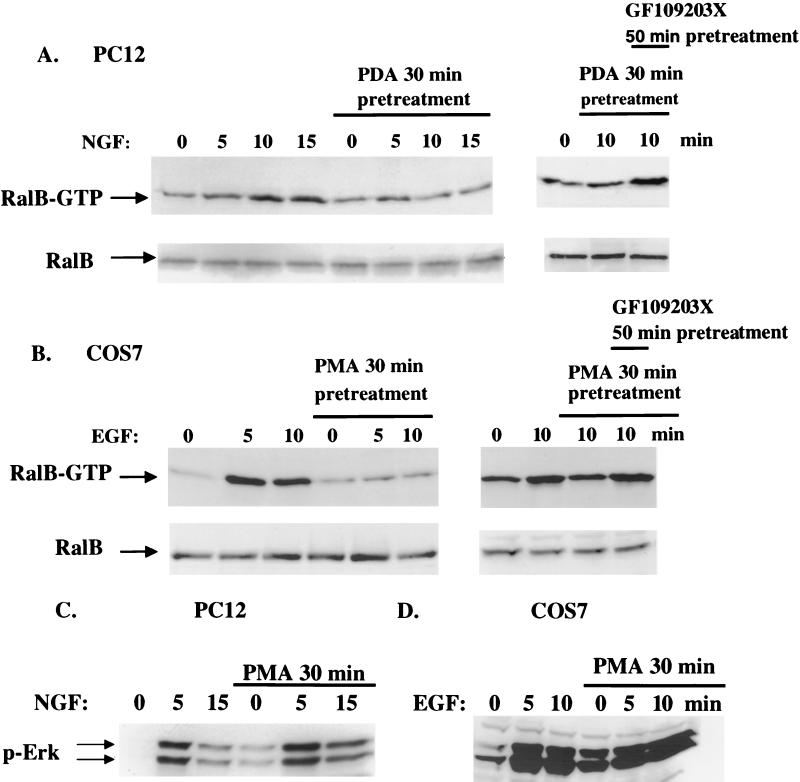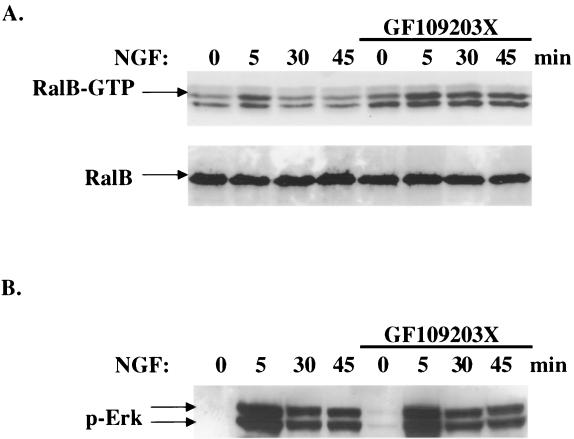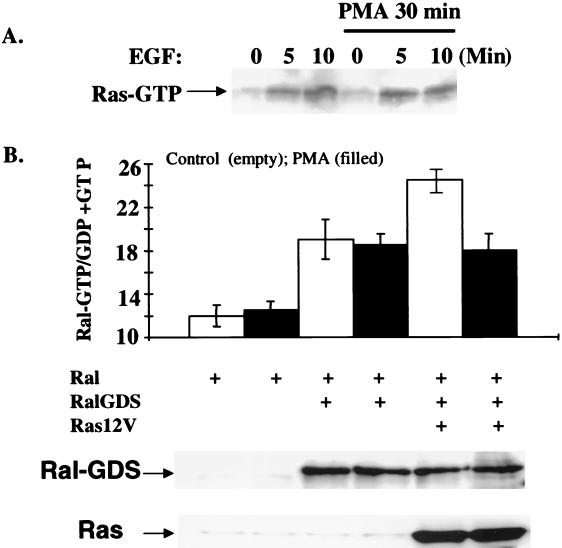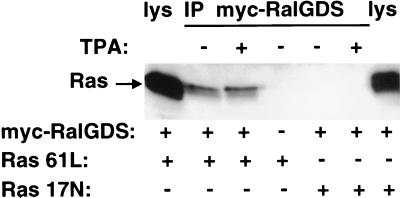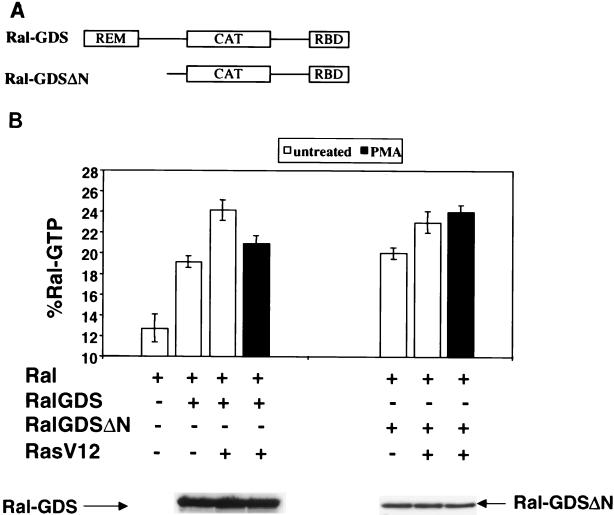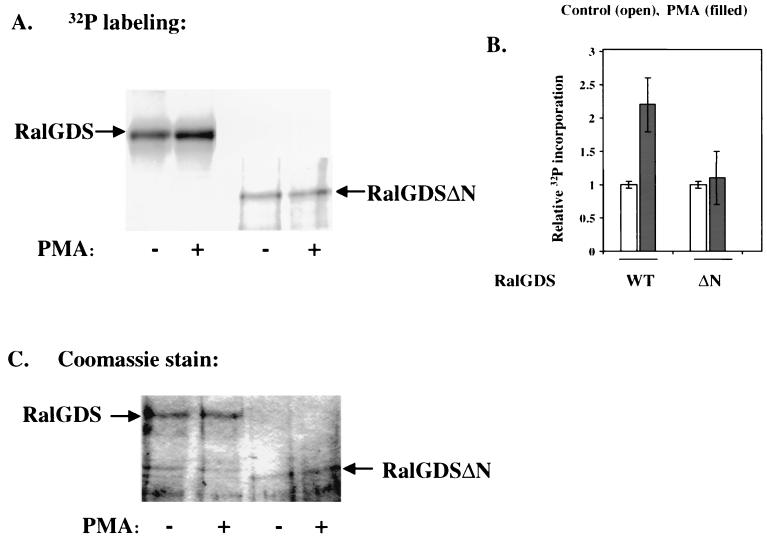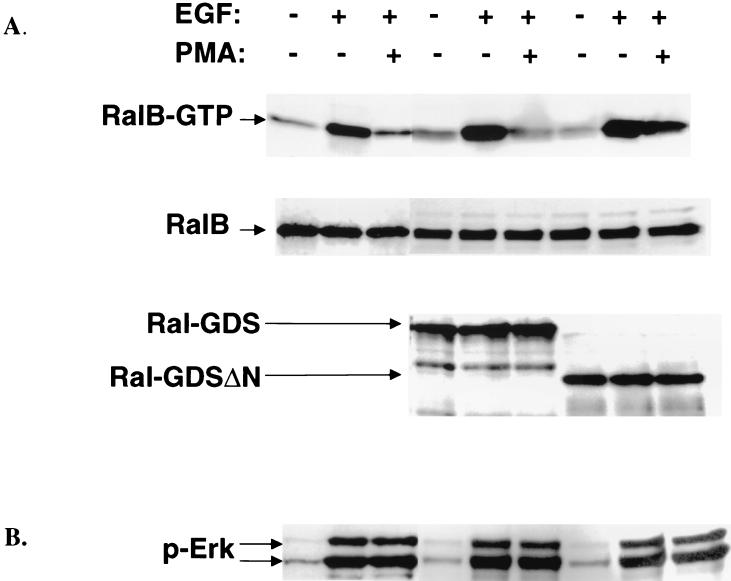Abstract
Ras proteins have the capacity to bind to and activate at least three families of downstream target proteins: Raf kinases, phosphatidylinositol 3 (PI 3)-kinase, and Ral-specific guanine nucleotide exchange factors (Ral-GEFs). We have previously shown that the Ras/Ral-GEF and Ras/Raf pathways oppose each other upon nerve growth factor stimulation, with the former promoting proliferation and the latter promoting cell cycle arrest. Moreover, the pathways are not activated equally. While the Ras/Raf/Erk signaling pathway is induced for hours, the Ras/Ral-GEF/Ral signaling pathway is induced for only minutes. Here we show that this preferential down-regulation of Ral signaling is mediated, at least in part, by protein kinase C (PKC). In particular, we show that PKC activation by phorbol ester treatment of cells blocks growth factor-induced Ral activation while it enhances Erk activation. Moreover, suppression of growth factor-induced PKC activation enhances and prolongs Ral activation. PKC does not influence the basal activity of the Ral-GEF designated Ral-GDS but suppresses its activation by Ras. Interestingly, Ras binding to the C-terminal Ras binding domain of Ral-GDS is not affected by PKC activity. Instead, suppression of Ral-GDS activation occurs through the region N terminal to the catalytic domain, which becomes phosphorylated in response to phorbol ester treatment of cells. These findings identify a role for PKC in determining the specificity of Ras signaling by its ability to differentially modulate Ras effector protein activation.
A large variety of extracellular signals influence cellular function in part by activating Ras proteins (for a review see reference 26). These include signals that function through receptor tyrosine kinases, cytokine receptors, integrins, G-protein-linked receptors, and calcium channels. How individual signals generate unique responses in cells while influencing only a limited number of intracellular signaling molecules like Ras is poorly understood. The fact that Ras proteins can activate more than one downstream target protein suggests that at least some level of signaling specificity may arise from differential activation of these proteins.
Ras proteins, H-Ras, N-Ras, and K-Ras, become active upon interaction with a family of guanine nucleotide exchange factors (GEFs), which promote the exchange of GTP for prebound GDP (17). Once active, Ras proteins bind to and activate at least three classes of proteins: Raf kinases, phosphatidylinositol (PI) 3-kinase, and Ral-specific GEFs (Ral-GEFs) (26). Raf proteins initiate a kinase cascade that leads to ERK activation, which can influence both cytosolic events and gene transcription in the nucleus (8). PI 3-kinase generates PIP3, which initiates a kinase cascade leading to AKT activation and suppression of apoptosis. PIP3 can have other effects in cells, including activation of Rac GTPases (23). Ral-GEFs activate the Ral GTPases RalA and RalB. Ral proteins influence phospholipase D (PLD) activity through association with PLD1 (10, 14) and influence the actin cytoskeleton through their actin-binding target, filamin (20), and their CDC42/Rac-GAP target, RalBP1 (1a, 11, 21). RalBP1 may also influence centrosome function (22) and endocytosis (12, 19). Ras/Ral signaling can also affect specific gene transcription pathways (18, 30) and participate in c-Src activation by epidermal growth factor (EGF) receptors (6).
In many cell types, the three Ras effector pathways complement each other to promote cell proliferation (30). However, in PC12 cells, the Ras/Ral-GEF signaling pathway antagonizes the Ras/Raf and Ras/PI 3-kinase pathways (5). In particular, Raf kinase and PI 3-kinase mediate the action of nerve growth factor (NGF) by promoting cell cycle arrest and neurite outgrowth. In contrast, Ral-GEF antagonizes NGF action by promoting cell proliferation and suppressing neurite outgrowth. Thus, in PC12 cells the relative ratio of Ras effector signaling can influence whether the cells differentiate or proliferate. Comparison of the temporal activation of Ral and Erk in NGF-stimulated PC12 cells revealed that these two Ras effector pathways are not activated equally. While NGF induces Ras and Erk activation for 1 to 2 h, NGF induces Ral activation for only ∼20 min (5). These findings suggest that NGF induces a negative signal that preferentially suppresses the Ras/Ral-GEF signaling pathway. Here we demonstrate that this negative signal is mediated, at least in part, by protein kinase C (PKC), which prevents Ral-GEF activation upon Ras binding. Thus, PKC activity represents one mechanism used by cells to regulate Ras signaling specificity.
MATERIALS AND METHODS
Plasmids.
The expression constructs for pCAGSB-Myc-Ral-GDS, pMT3-GST-Ral, and pMT3-RasH(61L) have been described previously (28). The N-terminal mutation of Ral-GDP dissociation stimulator (GDS) [Ral-GDS(ΔN)] was generated by PCR, where the first 297 codons of Ral-GDS were removed and the truncated cDNA was then cloned 3′ to a Myc epitope tag in the vector pMT3. pMT3-GST-RalA was constructed by placing wild-type RalA distal to the coding sequence of glutathione S-transferase (GST) in the vector pMT3. Bacterial expression vectors containing the Ral-GTP binding domain of RalBP1 (GST-RalBD) in pGEX2T or the Ras-GTP binding domain of c-Raf (GST-RafBD) in pGEX2TK were described previously (5).
Cell culture.
PC12 cells were grown in Dulbecco's modification of Eagle's medium (DMEM) supplemented with 10% (vol/vol) fetal calf serum and 5% horse serum. COS-7 cells were grown in DMEM containing 10% iron-enriched bovine calf serum (iron serum; HyClone). COS-7 cells (5 × 105 cells on a 60-mm culture dish) were transfected using the dextran sulfate procedure described previously (28) or by the use of Lipofectamine (Gibco). Forty-eight hours after transfection, the cells were serum deprived for 4 h, treated as necessary, and lysed.
Measurement of GTP-bound state of endogenous Ral and Ras.
PC12 or COS-7 cells were pretreated with phorbol 12,13-diacetate (PDA) (RBI), phorbol 12-myristate,13-acetate (PMA) (Calbiochem), or bisindolylmaleimide I (GF109203X; Calbiochem), and then with NGF or EGF as indicated. The cell lysates were then analyzed for the presence of the active forms of Ral (Ral-GTP) or Ras (Ras-GTP) by affinity purification using a GST fusion with either the Ral binding domain of RalBP (GST-RalBP) or the Ras binding domain of Raf (GST-Raf) immobilized on S-hexylglutathione-agarose beads (Sigma) as described previously (5). Immunoblots were visualized with either anti-RalB polyclonal antibodies (Transduction Laboratories) or anti-Ras monoclonal antibodies (Transduction Laboratories) by ECL (NEN). To quantify differences in Ras-GTP or Ral-GTP levels, serial dilutions of proteins purified with GST-RalBP1 or GST-Raf were used in Western blotting and were compared before and after experimental treatment.
Measurement of Ral-GDS activity in vivo.
COS-7 cells were transfected with pMT3-GST-RalA plus combinations of pMT3-Ral-GDS or pMT3-Myc-Ral-GDS(ΔN) and pMT3-RasH(12V) or (61L), as indicated. Forty-eight hours later the cells were switched to phosphate-free DMEM and metabolically labeled with 32PO4 (0.1 mCi/ml) for 4 h. After treatments, the cells were lysed and GST-Ral was affinity purified by using S-hexylglutathione–agarose beads. The Ral complexes were eluted from beads and separated by polyethyleneimine-cellulose thin-layer chromatography (TLC), as described previously (28). The TLC plates were scanned by a phosphorimager, and the percent GTP was calculated as counts of GTP/(counts of GTP + GDP).
In vivo phosphorylation of Ral-GDS.
COS-7 cells were transfected with pCAGSB-Myc-Ral-GDS or pMT3-Myc Ral-GDS(ΔN) and pMT3-RasH(61L). Forty-eight hours after transfection, the cells were put in phosphate-free DMEM containing 1% iron serum and metabolically labeled with 32PO4 (0.2 mCi/60-mm dish) overnight. Then the cells were left untreated or were treated with PMA for 30 min, washed twice with ice-cold phosphate-buffered saline, and lysed in 0.6 ml of buffer A, which contained 1% NP-40, 200 mM NaCl, 50 mM Tris-HCl (pH 7.5), 20 mM NaF, 10 mM Na4P2O7-NaH2PO4 (pH 7.6), 1 mM phenylmethylsulfonyl fluoride, and 10 μg of aprotinin per ml. After centrifugation, the supernatants were incubated with anti-Myc monoclonal antibody (9E10; Santa Cruz Biotechnology) for 1 h at 4°C and with protein A Sepharose (Pharmacia) for an additional 1 h. The immunocomplexes on Sepharose were then washed three times in lysis buffer and separated by sodium dodecyl sulfate-polyacrylamide gel electrophoresis (SDS-PAGE). The gel was stained with Coomassie blue, destained and dried, and then analyzed by a phosphorimager. The radioactive labeling of the transfected forms of Ral-GDS was quantified, while the Coomassie staining of these bands was compared to ensure that there were equal amounts of protein in each radioactive band.
Detection of Ral-GDS–Ras complexes in cells.
COS-7 cells were transfected with pCAGSB-Myc-Ral-GDS and either pMT3-RasH(61L) or pMT3- RasH(17N). Two days later, the cells were serum-deprived for 4 h, left untreated or treated with PMA for 30 minutes, and lysed in buffer A plus 5 mM MgCl2. The cleared lysates were incubated with anti-Myc antibody for 1 h, and then protein A Sepharose was added for another 1 h. The immune complexes were washed in lysis buffer and then subjected to SDS-PAGE and immunoblotting. The amount of Ras protein coprecipitated with Ral-GDS was visualized by staining the blots with anti-Ras antibody (Upstate Biotechnology) and by ECL detection.
RESULTS
NGF- and EGF-induced activation of the Ral GTPase is suppressed by PKC activity.
We previously showed that although NGF activates Ras and its downstream target protein Erk for 1 to 2 h in PC12 cells, it activates Ral proteins for only ∼20 min (5). This time-dependent dissociation of Ral from Ras activity suggests that NGF induces a signal that preferentially down-regulates the Ras-mediated Ral signaling pathway in these cells. Since NGF is known to activate PKC, we tested whether activation of PKC could suppress NGF induction of Ral (Fig. 1A, left). PC12 cells were pretreated with the PKC activator PDA for 30 min and then were exposed to NGF for varying lengths of time. The amount of active GTP-bound RalB was then determined by affinity purification of active RalB with the Ral binding domain of the Ral target protein, RalBP1, followed by immunoblotting with RalB antibodies. As we showed previously, NGF rapidly induced an increase in the amount of active GTP-bound RalB approximately twofold. Pretreatment of cells with PDA blocked NGF-induced activation of RalB. PDA functioned through PKC, since the addition of PKC inhibitor GF109203X to the cells reversed the effects of PDA (Fig. 1A, right). EGF is also known to activate Ral by a Ras-dependent pathway. To test the generality of the PKC effect on Ral activity, EGF enhancement of Ral-GTP levels in COS-7 cells (approximately sevenfold) was studied in a similar fashion. Here, too, pretreatment of cells with PDA blocked RalB activation in a PKC-dependent manner (Fig. 1B).
FIG. 1.
PKC activation suppresses growth factor activation of Ral but not Erk. Cells were pretreated with buffer, PDA, or PDA plus the PKC inhibitor GF109230X for 30 min. The cells were then stimulated for various amounts of time with growth factors, and the active state of either RalB (A and B) or Erk (C and D) was measured. (A) PC12 cells were stimulated with NGF with and without PMA and PKC inhibitor GF109230X, and active GTP-RalB was purified with the Ral binding domain of RalBP1. Total RalB in cell lysates is shown below. To quantify the difference in the amount of RalB-GTP between stimulated and unstimulated samples, serial dilutions of both samples were compared (data not shown). (B) COS-7 cells were stimulated with EGF and processed as for panel A. (C) PC12 cells were stimulated with NGF, and active Erk was measured in immunoblots using phospho-specific Erk antibodies. (D) COS-7 cells were stimulated with EGF and processed as described for panel C. Data are representative of at least three independent experiments.
For comparison, we studied the effect of phorbol ester treatment on NGF-induced Erk activation, a different downstream target of Ras. In contrast to its suppressive effects on the Ral signaling pathway, PDA increased basal Erk activity in PC12 cells and enhanced its activation in response to NGF (Fig. 1C). Similar results were obtained with EGF signaling in COS-7 cells (Fig. 1D). These findings are consistent with previous reports that showed a positive effect of PKC on Raf/Erk signaling (25).
To test whether activation of PKC by NGF in PC12 cells might contribute to the down-regulation of Ral after initial activation by NGF, the effect of suppressing PKC activation on RalB activity was assessed (Fig. 2). Cells were pretreated with the PKC inhibitor GF109203X for 30 min before stimulation with NGF for various times, and the quantity of active Ral-GTP in cells was measured as described above. Inhibition of PKC enhanced basal GTP-Ral levels and extended the length of time Ral remained active to over 45 min (Fig. 2A). No observable effect was seen on NGF-induced Erk activation (Fig. 2B). Together these findings suggest that receptor activation of PKC preferentially suppresses Ras-induced Ral activation. Thus, PKC activity may be used by cells to alter the specificity of Ras effector signaling.
FIG. 2.
Suppression of growth factor-induced PKC enhances Ral but not Erk activation. PC12 cells were stimulated with NGF in the presence or absence of the PKC inhibitor GF109230X, and either Ral activation (A) or Erk activation (B) was measured as for Fig. 1. Data are representative of at least three independent experiments.
PKC suppresses Ras activation of Ral-GDS.
To begin to investigate how PKC suppresses growth factor-induced activation of Ral, we determined which step in the signaling pathway from receptors to Ral is altered by PKC activity. We began by assessing the effect of PMA on Ras activation in response to NGF. In this assay, the Ras binding domain of Raf was used as an affinity reagent to isolate active GTP-bound Ras (Fig. 3A). Pretreatment of COS-7 cells with PMA did not suppress basal or EGF-stimulated Ras activity and actually enhanced NGF-induced Ras, indicating that PMA suppression of Ral activity acts downstream of Ras activation. This is consistent with our observation that PMA did not prevent NGF induction of ERK (see Fig. 1C).
FIG. 3.
PMA treatment of cells prevents Ral-GDS activation by Ras. (A) PMA does not block Ras activation by EGF. COS-7 cells were pretreated with either buffer or PMA and then stimulated with EGF for the indicated time. The amount of active Ras-GTP in cell lysates was determined by affinity purification with the Ras binding domain of Raf followed by immunoblotting with anti-Ras antibodies. The data are representative of at least two independent experiments. (B) PMA blocks Ras activation of Ral-GDS in vivo. GST-Ral was transfected alone or together with Ral-GDS or with Ral-GDS plus constitutively activated Ras12V. After being incubated with 32PO4 for 4 h to label nucleotide pools, cells were incubated with buffer or PMA for 30 min. GST-Ral was then isolated from cell extracts with glutathione beads, and the ratio of GTP/(GTP plus GDP) bound to Ral was determined by TLC. The data represent the average of three experiments ± standard deviations. The levels of transfected Ral-GDS and Ras are shown at the bottom.
To further define the step where PKC functions to inhibit Ral activity, an in vivo assay was used for Ral-GDS activation of Ral. Here, GST-Ral was transfected either alone, together with Ral-GDS, or together with Ral-GDS plus constitutively activated Ras. Cells were then incubated with 32P to metabolically label nucleotides. GST-Ral was then purified from cells, and the ratio of 32P-GTP/(GDP plus GTP) was determined after TLC analysis (Fig. 3B). As was shown previously (28), under control conditions the proportion of Ral in the GTP form was ∼12%. This proportion rose to ∼18% when Ral-GDS was coexpressed and increased to ∼25% when constitutively activated Ras was also included (Fig. 3B). We found that preincubation of cells with PMA had no effect on the basal Ral-GTP levels in cells (Fig. 3B). Moreover, PMA had no effect on the basal Ral-GDS activity against Ral. However, PMA did suppress the enhancement of Ral-GDS activity by Ras such that the Ral-GTP levels rose to only ∼21%, defining this activation step as the site of PKC action.
PKC does not prevent Ras binding to Ral-GDS.
An obvious potential explanation for PKC-induced suppression of Ral-GDS activation by Ras is that PKC blocks binding between Ras and Ral-GDS. To test this possibility, Myc-tagged Ral-GDS was transfected along with constitutively activated Ras or dominant negative Ras under the same conditions that were used in the Ral–Ral-GDS activity assay described above. Myc–Ral-GDS was then immunoprecipitated and immunoblotted for the presence of Ras (Fig. 4). As expected, Ral-GDS associated more effectively with constitutively activated Ras61L than with constitutively inactive, dominant-negative Ras17N. However, the Ral-GDS–Ras61L association was not altered by pretreatment with PMA, arguing for an alternative explanation for its inhibitory effects of Ral-GDS activation by Ras.
FIG. 4.
TPA treatment of cells does not prevent Ras binding to Ral-GDS. Cells were transfected as for Fig. 3 and treated with buffer or PMA. Myc-tagged Ral-GDS was then immunoprecipitated (IP) and immunoblotted for coprecipitated Ras61L. As a control, constitutively inactive Ras17N was transfected with Ral-GDS. The data are representative of two independent experiments. TPA, tetradecanoyl phorbol acetate.
Deletion of the N terminus of Ral-GDS suppresses PMA effects.
Since the C-terminal Ras binding domain of Ral-GDS did not appear to be involved in PKC action, the N-terminal region of GDS containing the Ras exchange motif (REM) and Ral-GDS-specific sequences upstream of the core catalytic domain was investigated. A Ral-GDS deletion mutant lacking this region [Ral-GDS(ΔN)] (see Fig. 5A) was compared with wild-type Ral-GDS in the GEF assay described for Fig. 3. Ras was still capable of enhancing the GEF activity of this mutant, but strikingly, this effect was not suppressed by pretreatment with PMA (Fig. 5B, top right). This finding implicates the N-terminal region of Ral-GDS in the mechanism of PKC action. Interestingly, although the basal activity of Ral-GDS(ΔN) appeared to be similar to that of wild-type Ral-GDS in these experiments, we routinely observed that the mutant protein was expressed at lower levels (see Fig. 5B, bottom). Since we have previously shown that Ral-GDS activity is proportional to its level of expression in these assays (28), these findings indicate that that deletion of the N terminus of Ral-GDS enhanced the protein's basal GEF activity. This is consistent with this region playing a negative role in Ral-GDS activity.
FIG. 5.
Deletion of the N terminus of Ral-GDS prevents PMA-induced suppression of Ral-GDS activation by Ras. (A) Map of Ral-GDS and an N-terminally truncated mutant, Ral-GDS(ΔN). CAT, catalytic domain; RBD, Ras binding domain. (B) Ral-GDS or Ral-GDS(ΔN) were transfected into COS-7 cells with GST-Ral or with GST-Ral plus constitutively activated Ras61L. Cells were treated with buffer or with PMA, and then the proportion of Ral in the GTP-bound state was measured as described for Fig. 3. The data represent the average of three independent experiments (± standard deviations).
PMA-induced phosphorylation of Ral-GDS is dependent upon the N-terminal region of the protein.
To determine whether changes in Ral-GDS phosphorylation could contribute to the suppressive effects of PMA on Ras/Ral signaling, the phosphorylation state of Myc epitope-tagged Ral-GDS was assessed in COS-7 cells cotransfected with constitutively activated Ras61L. Cells were metabolically labeled with 32PO4 and exposed to buffer or PMA, and Myc–Ral-GDS was then immunoprecipitated. PMA treatment did, in fact, increase the total phosphorylation of Ral-GDS by approximately twofold (Fig. 6A and B). Since we identified the N terminus of Ral-GDS as the site where PMA functions to block Ras effects, Ral-GDS(ΔN) was substituted for wild-type protein in this assay. Fig. 6A and B show that PMA treatment did not lead to enhanced phosphorylation of this mutant. Figure 6C shows that the same amount of each protein was present in immunoprecipitates before and after PMA treatment. These findings together with the GEF assays described above support the idea that PMA-induced activation of PKC prevents Ras activation of Ral-GDS through the N terminus of the exchange factor.
FIG. 6.
Deletion of the N terminus of Ral-GDS prevents PMA-induced hyperphosphorylation of Ral-GDS. (A) Ral-GDS or Ral-GDS(ΔN) were transfected into COS-7 cells and then labeled for 4 h with 32PO4. The cells were treated with either buffer or PMA, and then Ral-GDS and the mutant were immunoprecipitated and run on SDS-PAGE and the gel was exposed to phosphorimager analysis. (B) The signal from each Ral-GDS band from three experiments was quantified and expressed as an average ± standard error of the means. (C) The total amount of protein in the immunoprecipitates as determined by Coomassie staining is shown.
Expression of Ral-GDSΔN restores EGF activation of Ral in phorbol-treated cells.
The previous set of experiments documented that PKC functions through the N terminus of Ral-GDS when Ral signaling was activated by transfection of constitutively activated Ras. We next investigated whether PKC also functions through the N terminus of Ral-GDS to down-regulate Ral if it is activated by an extracellular ligand. We reasoned that if this hypothesis is correct, overexpressed Ral-GDS(ΔN), the PKC-insensitive form of Ral-GDS, should function as a dominant negative allele and should allow Ral activation by EGF even in phorbol ester-treated cells. In cells transfected with empty vector (Fig. 7A, lanes 1 through 3) or wild-type Ral-GDS (Fig. 7A, lanes 4 through 6), pretreatment with PMA blocked EGF-induced Ral activation, as described previously (Fig. 1). In contrast and as predicted above, in cells transfected with Ral-GDS(ΔN), Ral activation by EGF was sustained after PMA pretreatment (Fig. 7A, lanes 7 through 9). The small decrease in Ral activation in PMA-treated cells transfected with mutant Ral-GDS was likely due to the fact that only ∼70% of the COS-7 cells were transfected with Ral-GDS, whereas the GTP-bound state of endogenous Ral from all cells was measured. The effect of Ral-GDS(ΔN) was specific for the Ras/Ral-GEF pathway, since it did not influence EGF activation of Erk in the presence or absence of PMA (Fig. 7). These findings support the conclusion that PKC changes the specificity of Ras signaling specificity by altering the function of the N terminus of Ral-GDS.
FIG. 7.
Expression of Ral-GDS(ΔN) suppresses PKC down-regulation of Ral activation by EGF. COS-7 cells were transfected with either empty vector, Myc–Ral-GDS, or Myc–Ral-GDS(ΔN). Cells were then pretreated with either buffer or PMA for 25 min, followed by exposure to more buffer or EGF for an additional 5 min. (A) Active GTP-Ral was affinity purified from lysates of cells with the Ral binding domain of RalBP1 and then quantified by immunoblotting with anti-RalB antibodies. The level of transfected Ral-GDS and mutant were assayed with anti-Myc antibodies. (B) Active Erk was assessed by immunoblotting lysates with phospho-specific Erk antibodies. The data are representative of three independent experiments.
DISCUSSION
This paper documents that Ras signaling specificity can be modulated by PKC activity. This conclusion is based on our observation that elevated PKC activity inhibited the Ras/Ral-GEF/Ral signaling cascade, while it enhanced the Ras/Raf/Erk signaling cascade. This phenomenon was observed with both NGF-stimulated PC12 cells and EGF-stimulated COS-7 cells. Moreover, Ral activity was augmented and sustained for a longer period of time after NGF stimulation when PKC activation was blocked with the PKC inhibitor GF109203X. In contrast, this inhibitor had little, if any, effect on NGF induction of Erk activity. Thus, PKC activity in these cells changed the ratio of Ras effector signaling in favor of Erk activation over Ral activation.
We previously demonstrated that the ratio of Ras/Ral-GEF/Ral signaling to Ras/Raf/Erk signaling is an important determinant of PC12 cell fate (5). When we changed the ratio in favor of the Ral pathway by overexpression of Ral-GEF, we suppressed the rate of NGF-induced cell cycle arrest and neurite outgrowth. In contrast, when we changed the ratio in favor of the Erk pathway by expression of a dominant negative Ral mutant, we accelerated NGF-induced cell cycle arrest and neurite outgrowth (5). We also demonstrated that the ratio of Ral signaling to Erk signaling actually changes as a function of time after NGF stimulation of PC12 cells. For the first ∼10 min both Ras/Raf/Erk and Ras/Ral-GEF/Ral signaling are activated. However, Ral-GEF/Ral signaling then subsides, while Ras/Erk signaling is sustained for hours (5). The results presented here argue that the decrease in Ral-GEF/Ral signaling we observed in the face of continued Ras activation is due, at least in part, to growth factor-induced PKC activation. Overall, these findings suggest that PKC activity limits the suppressive effects of Ral proteins on neurite outgrowth by preferentially down-regulating the Ral-GEF pathway. As a consequence, Ral-GEF signaling may only delay but not prevent NGF-induced neurite outgrowth. In agreement with previous data from neuroblastoma cell lines (9), we found that NGF-induced differentiation was inhibited by pretreatment with the PKC inhibitor GF109230X (data not shown).
To pinpoint the mechanism of PKC-induced suppression of Ral activation, we followed the effects of PKC activation on major steps in the signaling pathway from growth factor to Ral. PKC did not affect ligand-induced activation of Ras, indicating that PKC functioned somewhere downstream of Ras. This finding is consistent with previous results showing that, if anything, PKC enhances Ras activation (3, 15). In addition, PKC activation did not suppress basal Ral-GTP levels in cells, suggesting that it did not function by enhancing Ral-GAP activity. Similarly, PKC activation also did not dramatically affect the basal activity of Ral-GDS. The only effect we did observe was a suppression of Ral-GDS activation by Ras.
We first investigated the simple idea that PKC affects Ras/Ral signaling by inhibiting Ras binding to the C-terminal Ras binding domain of the protein. However, we could not detect an effect of phorbol ester treatment on Ras–Ral-GDS binding in cells. These findings suggested that PKC worked through a different region of the protein by a previously undetected mechanism of Ral-GDS regulation.
Deletion analysis demonstrated that PKC functions through the segment of Ral-GDS N terminal to its core catalytic domain. In particular, removal of the first 290 amino acids of the protein blocked both phorbol ester-induced phosphorylation of Ral-GDS and phorbol ester-induced suppression of Ras-mediated Ral-GDS activation. In addition, expression of this deleted form of Ral-GDS functioned like a dominant inhibitory mutant in that it blocked PKC-mediated down-regulation of Ral activation by EGF. Deletion of the N-terminal region also enhanced the basal activity of Ral-GDS, which is consistent with its playing a negative regulatory role in Ral-GDS function. This region of the protein contains the REM, which is found in most but not all GEFs for the Ras subfamily GTPases, Ras, Rap, R-Ras, and Ral (see Fig. 3A). The function of the REM is not well understood, although for the Ras-GEF designated SOS, it appears to stabilize the core catalytic domain (1). The REM of Ral-GDS does contain four of the six potential PKC sites in the N terminus of the protein, raising the possibility that phosphorylation of REMs participates in the regulation of GEF activity in cells.
Ras is thought to activate Ral-GDS by targeting it to its substrate Ral in the plasma membrane (16). This is analogous to the activation mechanism of SOS, which is targeted to Ras by binding the adapter protein Grb2 (13). However, since we observed that only the Ras-responsive fraction of Ral-GDS activity was affected by PKC, it is possible that the mechanism underlying down-regulation of Ral-GDS by PKC is related to the activation mechanism associated with Ras binding. Moreover, PKC's ability to suppress Ras activation of Ral-GDS without affecting either binding between the two proteins or basal Ral-GDS activity argues that full Ral-GDS activation by Ras requires a secondary event that can be blocked by PKC activity. This model is analogous to the multiple activation steps involved in the activation of another Ras target protein, the Raf kinase (8). It is also consistent with the previous finding that Rap and R-Ras GTPases can bind to Ral-GDS in 293 cells but cannot activate it (28). The identity of this putative additional step in Ral-GDS activation is presently under investigation.
At present it is not clear which PKC isoform is responsible for down-regulation of Ral-GDS in response to NGF and EGF. The fact that the effect can be seen after PMA treatment argues that it is through the phorbol-responsive conventional PKCs alpha, beta, or gamma and/or the novel PKCs delta, epsilon, eta, or theta but not the atypical PKCs zeta and lambda. It also remains to be determined how PKC becomes activated, because multiple types of signaling molecules can enhance PKC activity in cells (for a review see reference 27). For example, some PKC family members can be activated by diacylglycerol and calcium generated by NGF or EGF receptor-induced phospholipase C activation. Alternatively, Ras-Ral-regulated PLD could conceivably activate PKC isoforms, since the PLD product, phosphatidic acid, is known to be converted to diacylglycerol (4).
Since PKCs can be activated by many types of cell surface receptors through multiple signaling molecules, Ras effector signaling specificity may vary depending on the particular receptor engaged. In other words, how Ras becomes activated may influence its downstream signaling specificity. We have recently documented that this is also the case for c-Src activation in cells (6). In addition, PKC offers a mechanism for cross-talk that allows receptors that do not normally activate Ras to influence Ras signaling specificity. Modulation of Ras effector specificity could be one way that individual receptors generate specific cellular responses.
Ral-GDS is only one of a family of Ral-GEFs. Many contain Ras binding sites and may be regulated in a manner similar to that of Ral-GDS. However, some Ral-GEFs do not contain Ras binding sites (7, 24), consistent with the fact that in some cases Ral can be activated in a Ras-independent manner. Furthermore, in at least one cell type, phorbol ester treatment activates Ral (29). Presumably, this cell type contains a phorbol-responsive Ral-GEF. Thus, it is likely that the regulation of Ral-GEF activity differs in various cell types and that other signaling molecules controlling the ratio of Ral-GEF/Ral signaling to Raf/Erk signaling remain to be elucidated.
ACKNOWLEDGMENTS
This research was supported by a PHS grant from NIGMS awarded to L.A.F. and by an American Cancer Society post-doctoral fellowship awarded to G.R.
REFERENCES
- 1.Boriack-Sjodin P A, Margarit S M, Bar-Sagi D, Kuriyan J. The structural basis of the activation of Ras by Sos. Nature. 1998;394:337–343. doi: 10.1038/28548. [DOI] [PubMed] [Google Scholar]
- 1a.Cantor S, Urano T, Feig L A. Identification and characterization of RalBP1, a potential downstream target of Ral GTPases. Mol Cell Biol. 1995;15:4578–4584. doi: 10.1128/mcb.15.8.4578. [DOI] [PMC free article] [PubMed] [Google Scholar]
- 2.Damon D H, D'Amore P A, Wagner J A. Nerve growth factor and fibroblast growth factor regulate neurite outgrowth and gene expression in PC12 cells via both protein kinase C- and cAMP-independent mechanisms. J Cell Biol. 1990;110:1333–1339. doi: 10.1083/jcb.110.4.1333. [DOI] [PMC free article] [PubMed] [Google Scholar]
- 3.Downward J, Graves J D, Warne P H, Rayter S, Cantrell D A. Stimulation of p21 ras upon T-cell activation. Nature. 1990;346:719–723. doi: 10.1038/346719a0. [DOI] [PubMed] [Google Scholar]
- 4.Exton J H. Regulation of phospholipase D. Biochim Biophys Acta. 1999;1439:121–133. doi: 10.1016/s1388-1981(99)00089-x. [DOI] [PubMed] [Google Scholar]
- 5.Goi T, Rusanescu G, Urano T, Feig L A. Ral-specific guanine nucleotide exchange factor activity opposes other Ras effectors in PC12 cells by inhibiting neurite outgrowth. Mol Cell Biol. 1999;19:1731–1741. doi: 10.1128/mcb.19.3.1731. [DOI] [PMC free article] [PubMed] [Google Scholar]
- 6.Goi T, Shipistin M, Lu Z, Foster D A, Klinz S, Feig L A. An EGF receptor/Ral-GTPase signaling cascade regulates c-Src activity and substrate specificity. EMBO J. 2000;19:623–630. doi: 10.1093/emboj/19.4.623. [DOI] [PMC free article] [PubMed] [Google Scholar]
- 7.Gotoh T, Cai D, Tian X, Feig L A, Lerner A. p130Cas regulates the activity of AND-34, a novel ral, rap1, and R-Ras guanine nucleotide exchange factor. J Biol Chem. 2000;275:30118–30123. doi: 10.1074/jbc.M003074200. [DOI] [PubMed] [Google Scholar]
- 8.Hagemann C, Rapp U R. Isotype-specific functions of Raf kinases. Exp Cell Res. 1999;253:34–46. doi: 10.1006/excr.1999.4689. [DOI] [PubMed] [Google Scholar]
- 9.Hall F L, Fernyhough P, Ishii D N, Vulliet P R. Suppression of nerve growth factor-directed neurite outgrowth in PC12 cells by sphingosine, an inhibitor of protein kinase C. J Biol Chem. 1988;263:4460–4466. [PubMed] [Google Scholar]
- 10.Jiang H, Luo J Q, Urano T, Frankel P, Lu Z, Foster D A, Feig L A. Involvement of Ral GTPase in v-Src-induced phospholipase D activation. Nature. 1995;378:409–412. doi: 10.1038/378409a0. [DOI] [PubMed] [Google Scholar]
- 11.Jullien-Flores V, Dorseuil O, Romero F, Letourneur F, Saragosti S, Berger R, Tavitian A, Gacon G, Camonis J H. Bridging Ral GTPase to Rho pathways. J Biol Chem. 1995;270:22473–22477. doi: 10.1074/jbc.270.38.22473. [DOI] [PubMed] [Google Scholar]
- 12.Kariya K, Koyama S, Nakashima S, Oshiro T, Morinaka K, Kikuchi A. Regulation of complex formation of POB1/Epsin/AP-2 by mitotic phosphorylation. J Biol Chem. 2000;275:18399–18406. doi: 10.1074/jbc.M000521200. [DOI] [PubMed] [Google Scholar]
- 13.Lowenstein E J, Daly R J, Batzer A G, Li W, Margolis B, Lammers R, Ullrich A, Skolnik E Y, Bar-Sagi D, Schlessinger J. The SH2 and SH3 domain-containing protein GRB2 links receptor tyrosine kinases to ras signaling. Cell. 1992;70:431–442. doi: 10.1016/0092-8674(92)90167-b. [DOI] [PubMed] [Google Scholar]
- 14.Luo J Q, Liu X, Hammond S M, Colley W C, Feig L A, Frohman M A, Morris A J, Foster D A. RalA interacts directly with the Arf-responsive, PIP2-dependent phospholipase D1. Biochem Biophys Res Commun. 1997;235:854–859. doi: 10.1006/bbrc.1997.6793. [DOI] [PubMed] [Google Scholar]
- 15.Marais R, Light Y, Mason C, Paterson H, Olson M F, Marshall C J. Requirement of Ras-GTP-Raf complexes for activation of Raf-1 by protein kinase C. Science. 1998;280:109–112. doi: 10.1126/science.280.5360.109. . (Erratum, 280:987.) [DOI] [PubMed] [Google Scholar]
- 16.Matsubara K, Kishida S, Matsuura Y, Kitayama H, Noda M, Kikuchi A. Plasma membrane recruitment of RalGDS is critical for Ras-dependent Ral activation. Oncogene. 1999;18:1303–1312. doi: 10.1038/sj.onc.1202425. [DOI] [PubMed] [Google Scholar]
- 17.McCormick F. Activators and effectors of Ras p21 proteins. Curr Opin Genet Dev. 1994;4:71–76. doi: 10.1016/0959-437x(94)90093-0. [DOI] [PubMed] [Google Scholar]
- 18.Nakae J, Park B C, Accili D. Insulin stimulates phosphorylation of the forkhead transcription factor FKHR on serine 253 through a wortmannin-sensitive pathway. J Biol Chem. 1999;274:15982–15985. doi: 10.1074/jbc.274.23.15982. [DOI] [PubMed] [Google Scholar]
- 19.Nakashima S, Morinaka K, Koyama S, Ikeda M, Kishida M, Okawa K, Iwamatsu A, Kishida S, Kikuchi A. Small G protein Ral and its downstream molecules regulate endocytosis of EGF and insulin receptors. EMBO J. 1999;18:3629–3642. doi: 10.1093/emboj/18.13.3629. [DOI] [PMC free article] [PubMed] [Google Scholar]
- 20.Ohta Y, Suzuki N, Nakamura S, Hartwig J H, Stossel T P. The small GTPase RalA targets filamin to induce filopodia. Proc Natl Acad Sci USA. 1999;96:2122–2128. doi: 10.1073/pnas.96.5.2122. [DOI] [PMC free article] [PubMed] [Google Scholar]
- 21.Park S H, Weinberg R A. A putative effector of Ral has homology to Rho/Rac GTPase activating proteins. Oncogene. 1995;11:2349–2355. [PubMed] [Google Scholar]
- 22.Quaroni A, Paul E C. Cytocentrin is a Ral-binding protein involved in the assembly and function of the mitotic apparatus. J Cell Sci. 1999;112:707–718. doi: 10.1242/jcs.112.5.707. [DOI] [PubMed] [Google Scholar]
- 23.Rameh L E, Cantley L C. The role of phosphoinositide 3-kinase lipid products in cell function. J Biol Chem. 1999;274:8347–8350. doi: 10.1074/jbc.274.13.8347. [DOI] [PubMed] [Google Scholar]
- 24.Rebhun J F, Chen H, Quilliam L A. Identification and characterization of a new family of guanine nucleotide exchange factors for the Ras-related GTPase Ral. J Biol Chem. 2000;275:13406–13410. doi: 10.1074/jbc.c000085200. [DOI] [PubMed] [Google Scholar]
- 25.Schonwasser D C, Marais R M, Marshall C J, Parker P J. Activation of the mitogen-activated protein kinase/extracellular signal-regulated kinase pathway by conventional, novel, and atypical protein kinase C isotypes. Mol Cell Biol. 1998;18:790–798. doi: 10.1128/mcb.18.2.790. [DOI] [PMC free article] [PubMed] [Google Scholar]
- 26.Shields J M, Pruitt K, McFall A, Shaub A, Der C J. Understanding Ras: ‘it ain’t over ‘til it’s over.'. Trends Cell Biol. 2000;10:147–154. doi: 10.1016/s0962-8924(00)01740-2. [DOI] [PubMed] [Google Scholar]
- 27.Toker A. Signaling through protein kinase C. Front Biosci. 1998;3:D1134–D1147. doi: 10.2741/a350. [DOI] [PubMed] [Google Scholar]
- 28.Urano T, Emkey R, Feig L A. Ral-GTPases mediate a distinct downstream signaling pathway from Ras that facilitates cellular transformation. EMBO J. 1996;16:810–816. [PMC free article] [PubMed] [Google Scholar]
- 29.Voss M, Weernink P A, Haupenthal S, Moller U, Cool R H, Bauer B, Camonis J H, Jakobs K H, Schmidt M. Phospholipase D stimulation by receptor tyrosine kinases mediated by protein kinase C and a Ras/Ral signaling cascade. J Biol Chem. 1999;274:34691–34698. doi: 10.1074/jbc.274.49.34691. [DOI] [PubMed] [Google Scholar]
- 30.Wolthuis R M, de Ruiter N D, Cool R H, Bos J L. Stimulation of gene induction and cell growth by the Ras effector Rlf. EMBO J. 1997;16:6748–6761. doi: 10.1093/emboj/16.22.6748. [DOI] [PMC free article] [PubMed] [Google Scholar]



